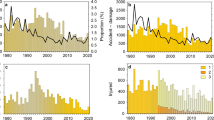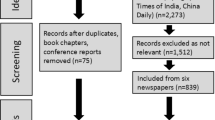Abstract
Inclement weather creates a chronic hazard for Canadian travellers. Past studies indicate that road collision rates increase during precipitation, although the magnitude of theincrease varies from study to study, partly as a result of variations in weather and driving conditions,but also because of differences in methods. The goal of the current study is to improve ourunderstanding of the links between weather and travel risk in mid-sized Canadian cities by using astandardized method for analyzing data from six cities with different climates: Halifax-Dartmouth,Ottawa, Québec, Hamilton, Waterloo Region, and Regina. The study has four interrelated objectives: (1) Toconduct a sensitivity analysis to determine the extent to which risk estimates vary depending onthe criteria used to define precipitation events and `normal' conditions; (2) To compare therelative risk of collision and injury during precipitation relative to `normal' conditions; (3) Todetermine the extent to which weather-related risks vary fordifferent Canadian cities; and (4) To explore any differences in collision characteristics between events and controls, especially as theyvary from city to city. Results are based on a matched-pair analysis, using six-hour time blocks over afour-year period, 1995 to 1998. Results indicate only modest sensitivity to the criteria used to define precipitation events and `normal' conditions. On average, precipitation is associated with a 75 percentincrease in traffic collisions and a 45 percent increase in related injuries, as compared to `normal'seasonal conditions, but risk levels vary depending on the characteristics of the weather event.Both sensitivity to specific weather conditions and weather-related accident profiles vary from city tocity in ways that are not easily explained.
Similar content being viewed by others
References
Adams, J.: 1985, Risk and Freedom: The Record of Road Safety Regulators, Bottesford Press, Nottingham.
Andreescu, M. and Frost, D. B.: 1998, Weather and traffic accidents in Montreal, Canada, Climate Research 9, 225–230.
Andrey, J. and Olley, R.: 1990, The relationship between weather and road safety: Past and future research directions, Climatological Bulletin 24, 123–127.
Andrey, J. and Yagar, S.: 1993, A temporal analysis of rain-related crash risk, Accident Analysis and Prevention 25, 465–472.
Andrey, J.: 1989, Relationships between Weather and Traffic Safety, Ph.D. Dissertation, University of Waterloo, Waterloo, Ontario.
Baranowska, M. and Gabryl, B.: 1981, Biometeorological norm as tolerance interval of man to weather stimuli, International Journal of Biometeorology 25, 123–126.
Bertness, J.: 1980, Rain related impacts on selected transportation activities and utility services in the Chicago area, Journal of Applied Meteorology 19, 545–556.
Brodsky, H. and Hakkert, S.: 1988, Risk of a road accident in rainy weather, Accident Analysis and Prevention 20, 161–176.
CCMTA: 2000, Road Safety Vision 2001 – 2000 Update, Transport Canada, Ottawa, http://www.tc.gc.ca/roadsafety/vision/2000/pdf/RSV.pdf. Accessed June 2001.
Changnon, S.: 1979, How a severe winter impacts on individuals, Bulletin of the American Meteorological Society 60(2), 110–114.
Changnon, S.: 1996, Effects of summer precipitation on urban transportation, Climatic Change 32, 481–494.
Clissold, C.: 1977, Wet weather injury accidents on New Zealand roads, Transportation Research Record 624, 135–139.
Codling, P.: 1974, Weather and road accidents, In: J. Taylor (ed), Climatic Resources and Economic Activity, David and Charles Holdings, Newton Abbot, pp. 205–222.
de Freitas, C.R.: 1975, Estimation of the disruptive impact of snowfalls in urban areas, Journal of Applied Meteorology 14, 1166–1173.
Doherty, S. T.: 1994, Young Drivers' Mobility Patterns and Exposure to Risk: Assessment and Management, Unpublished Masters Thesis, Department of Geography, University of Waterloo, Waterloo, Ontario.
Earney, F. and Knowles, B.: 1974, Urban snow hazard: Marquette, Michigan, In: G. White (ed.), Natural Hazards: Local, National, Global, Oxford University Press, Oxford, pp. 167–174.
Edwards, J.: 1996, Weather-related road accidents, Journal of Transport Geography 4, 201–212.
EPC: 2001, EPC Disaster Database version 2.0, http://www.ocipepbpiepc. gc.ca/research/epcdatab_e.html, Accessed June 2001.
Evans, L.: 1991, Traffic Safety and the Driver, Van Nostrand Reinhold, New York.
Fridstrom, L. and Ingebridsten, S.: 1991, An aggregate accident model based on pooled regional time series data, Accident Analysis and Prevention 23, 363–378.
Fridstrom, L., Ifver, J., Ingebrigtsen, S., and Kulmala, R.: 1995, Measuring the contribution of randomness, exposure, weather and daylight to the variation in road accident counts, Accident Analysis and Prevention 27, 1–20.
Gillespie, K.: 1999, One day later, drivers still race through fog, Toronto Star, September 5, A2.
Haghigh-Talab, D.: 1973, An investigation into the relationship between rainfall and road accident frequencies in two cities, Accident Analysis and Prevention 5, 343–349.
Hanbali, R. and Kuemmel, D.: 1993, Accident analysis of ice control operations, Public Works 124, 48–51.
Hassan, Y. A. and Barker, J. J. 1999. The impact of unseasonable or extreme weather on traffic activity within Lothian region, Scotland, Journal of Transport Geography 7, 209–213.
Health Canada, Statistics Canada, and the Canadian Institute for Health Information: 1999, Statistical Report on the Health of Canadians, Report commissioned by the Federal, Provincial and Territorial Advisory Committee on Population Health for the Meeting of Ministers of Health, Charlottetown, P.E.I., September 16–17, 1999, Health Canada, Ottawa.
Henry, J. J.: 2000, Evaluation of pavement friction characteristics, NCHRP Synthesis of Highway Practice 291, Transportation Research Board, National Research Council, Washington.
Huebner, R. S., Anderson, D. A., and Warner, J. C.: 1999, Proposed design guidelines for reducing hydroplaning on new and rehabilitated pavements, National Cooperative Highway Research Program Research Results Digest, No. 243, Transportation Research Board, National Research Council, Washington.
Ivey, D., Griffin, L, Newton, T, Lytten, R. and Hankins, K.: 1981, Predicting wet weather accidents, Accident Analysis and Prevention 13, 83–99.
Jovanis, P. and Delleur, J.: 1983, Exposure-based analysis of motor vehicle accident, Transportation Research Record 910, 1–7.
Khattak, A. and Knapp, K.: 2001, Interstate highway crash injuries during winter snow and nonsnow events, In: Transportation Research Board, Proceedings of the 80th Annual Meeting of the Transportation Research Board, Washington.
Knapp, K., Smithson, L., and Khattak, A.: 2000, The use of multiple data sources to evaluate the volume and safety impacts of winter storm events, www.ctre.iastate.edu/reports/CTRE_rep.htm.
Levine, N., Kim, K. and Nitz, L.: 1995, Daily fluctuations in Honolulu motor vehicle crashes, Accident Analysis and Prevention 27, 785–796.
Mende, I.: 1982, An Analysis of Snowstorm-Related Accidents in Metropolitan Toronto, Master's Thesis, Department of Civil Engineering, University of Toronto, Toronto.
Mercer, G.: 1986, Aspects of Weather-Related Casualty Traffic Accidents, British Columbia, 1984, British Columbia Ministry of Attorney General, Police Services Branch, Victoria, B.C.
Mills, B., Suggett, J., and Wenger, L.: 2002, You and who's army: A review of the 1999 Toronto snow emergency, In: J. Andrey and C. Knapper (eds), Weather and Transportation, Department of Geography Monograph Series 55, University of Waterloo.
MTO: 1994, The Social Cost ofMotor Vehicle Crashes in Ontario, Safety Policy Branch, Downsview.
MTO: 1999, Ontario Road Safety Annual Report, Road Safety Program Of-fice, Road User Safety Branch, Ontario Ministry of Transportation, Toronto, http://www.mto.gov.on.ca/english/safety/orsar/.Accessed June 2001.
Musk, L.: 1982, The local fog hazard as a factor in planning new roads and motorways, Environmental Education and Information 2, 119–129.
Nofal, F. and Saeed, A.: 1997, Seasonal variations and weather effects on road traffic accidents in Riyadh City, Public Health 111, 51.
OECD (Organization for Economic Cooperation and Development): 1976, Adverse Weather, Reduced Visibility and Road Safety, OECD, Paris.
Orne, D. and Yang, A.: 1972, An investigation of weather factor effects on traffic accidents, Traffic Engineering 43, 14–20.
Palutikof, J.: 1983, The effect of climate on road transport, Climate Monitor 12, 46–53.
Pike, W.: 1992, Three motorway traffic accidents in hail showers on 29 March 19986: A radar study, Meteorological Magazine 121, 84–88.
Roer, P.: 1972, Effects of some non-transportation factors on the incidence and severity of traffic accidents, The Logistics and Transportation Review 10, 165–179.
Rooney, J. R. Jr.: 1967, The urban snow hazard in the United States, Geographical Review 57, 538–559.
Satterthwaite, S.: 1976, An assessment of seasonal and weather effects on the frequency of road accidents in California, Accident Analysis and Prevention 8, 96.
Scott, P.: 1983, Variations in two-vehicle accident frequencies 1970–1978, Transport and Road Research Laboratory Report 1086, Crowthorne, Berkshire, England.
Shankar, V., Mannering, F., and Barfield, W.: 1995, Effect of roadway geometrics and environmental factors on rural freeway accident frequencies, Accident Analysis and Prevention 27, 371–389.
Sherretz, L. and Farhar, B.: 1978, An analysis of the relationship between rainfall and the occurrence of traffic accidents, Journal of Applied Meteorology 17, 711–715.
Smeed, R.: 1953, Some factors affecting visibility from a driver's seat and their effect on road safety, British Journal of Physiology Optics 10, 63–85.
Smith, K.: 1982, How seasonal and weather conditions influence road accidents in Glasgow, Scottish Geographical Magazine 98, 103–114.
Storie, V.: 1984, Involvement of goods vehicles and public service vehicles in motorway accidents, Transport and Road Research Laboratory Report 1113, Crowthorne, Berkshire, England.
Suggett, J.: 1999, The Effect of Precipitation on Traffic Safety in the City of Regina,Master of Science thesis, University of Regina, Saskatoon.
Thomas, R. and Gallon, C.: 1988, Motorway accidents: Associations between characteristics-related variables, Traffic Engineering and Control 29, 456–465.
Transport Canada: 1998, Canadian Motor Vehicle Traffic Collision Statistics, TP 3322, http://www.tc.gc.ca/roadsafety/STATS/stats98/RK_98E.pdf. Accessed June 2001.
Tudor, C.: 1997, EPC Electronic Disaster Database and its Characteristics, Project Report 97-1, Office of the Senior Scientific Advisor, Emergency Preparedness Canada, Ottawa, http://www.ocipep-bpiepc.gc.ca/research/down/en_disrep.pdf. Accessed June 2001.
Author information
Authors and Affiliations
Rights and permissions
About this article
Cite this article
Andrey, J., Mills, B., Leahy, M. et al. Weather as a Chronic Hazard for Road Transportation in Canadian Cities. Natural Hazards 28, 319–343 (2003). https://doi.org/10.1023/A:1022934225431
Issue Date:
DOI: https://doi.org/10.1023/A:1022934225431




